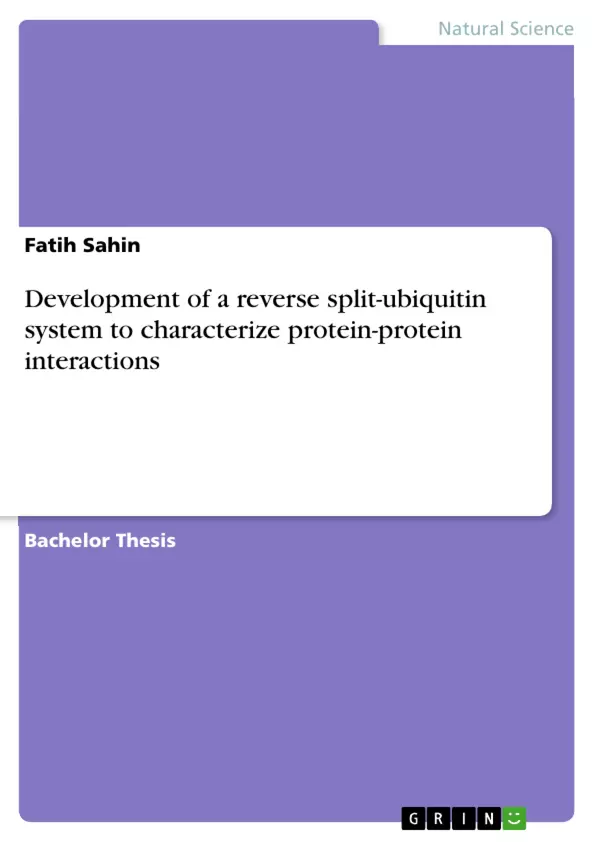An important topic in research is the study of interactions between proteins. Therefore, many strategies have been developed to better understand these interactions. One method is the yeast two-hybrid system.
The glo-1(QL) gene encodes a Rab GTPase and is localized in lysosomal organelles. Several effector proteins have been found for the glo-1 gene. One of them is C35B1.2a.
Using the yeast two-hybrid system, the interaction between GLO-1(QL) and C35B1.2a should be shown. In addition, the expression rate of the interaction partners should be documented by promoter exchange. However, this system is not suitable for all proteins. For this reason, the reverse split ubiquitin system was developed. A yeast-two-hybrid system-based method to study protein-protein interactions (PPI) of membrane proteins. In this case, the ubiquitin is cleaved into an N-terminal domain (Nub) and C-terminal (Cub) domain, each domain being fused to a protein. The C-terminal domain additionally consists of an arginine and subsequent reporter gene. If there is an interaction of the two fusion proteins, this is recognized by so-called ubiquitin-specific proteases (USPs) and cut the ubiquitin apart. Subsequently, the reporter gene is degraded due to the arginine.
In this study, the interaction could not be demonstrated because no clones grew on selective plates. Even by the replacement of the promoters no growth could be found. To optimize the interaction, the split ubiquitin system should be further refined.
Inhaltsverzeichnis (Table of Contents)
- Zusammenfassung
- Abstract
- List of Abbreviations
- 1 Introduction
- 1.1 Protein-protein interactions
- 1.2 Yeast two-hybrid system
- 1.3 Reverse split-ubiquitin system
- 2 Materials and Methods
- 2.1 Plasmids and strains
- 2.2 Cloning strategy
- 2.3 Transformation
- 2.4 Yeast cultivation and selection
- 2.5 Yeast growth assay
- 2.6 Western blotting
- 3 Results
- 3.1 Cloning of GLO-1(QL) and C35B1.2a into the vectors
- 3.2 Yeast transformation and selection
- 3.3 Yeast growth assay
- 3.4 Western blot analysis
- 4 Discussion
- 5 References
Zielsetzung und Themenschwerpunkte (Objectives and Key Themes)
This bachelor thesis focuses on the development and application of a reverse split-ubiquitin system to characterize protein-protein interactions (PPIs) of membrane proteins. The study aims to demonstrate the interaction between GLO-1(QL), a Rab GTPase, and its effector protein C35B1.2a using this system.
- Protein-protein interactions (PPIs) in biological processes
- Yeast two-hybrid system and its limitations
- Reverse split-ubiquitin system for studying PPIs of membrane proteins
- Interaction of GLO-1(QL) and C35B1.2a
- Optimization of the split-ubiquitin system
Zusammenfassung der Kapitel (Chapter Summaries)
- Chapter 1: Introduction Provides an overview of protein-protein interactions, the yeast two-hybrid system, and the reverse split-ubiquitin system as methods for studying these interactions. It introduces the GLO-1(QL) gene, its role in lysosomal organelles, and its effector protein C35B1.2a.
- Chapter 2: Materials and Methods Details the experimental procedures employed in this study, including cloning strategies, transformation methods, yeast cultivation and selection techniques, yeast growth assays, and Western blotting analysis.
- Chapter 3: Results Presents the results of the cloning, transformation, selection, growth assays, and Western blotting experiments, including the challenges encountered in demonstrating the interaction between GLO-1(QL) and C35B1.2a.
- Chapter 4: Discussion Analyzes the findings, discusses the limitations of the split-ubiquitin system used in this study, and suggests potential improvements to the system for future investigations.
Schlüsselwörter (Keywords)
The study focuses on protein-protein interactions, membrane proteins, yeast two-hybrid system, reverse split-ubiquitin system, GLO-1(QL), C35B1.2a, Rab GTPase, lysosomal organelles, PPI, Nub, Cub, USPS, reporter gene, optimization.
- Arbeit zitieren
- Fatih Sahin (Autor:in), 2018, Development of a reverse split-ubiquitin system to characterize protein-protein interactions, München, GRIN Verlag, https://www.grin.com/document/477201



